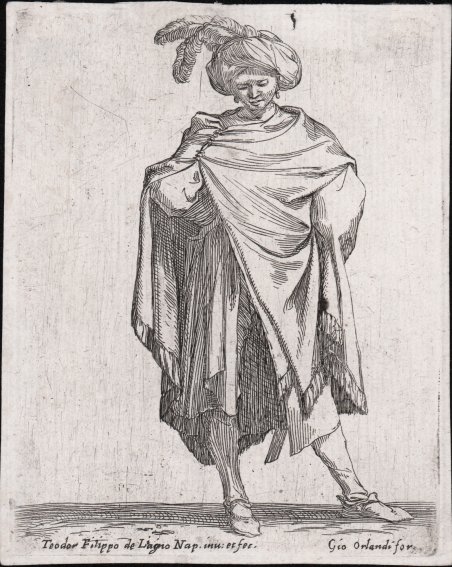Acquaforte, circa 1622, firmata in basso 'Teodor Filippo de Liagno Nap inv et fec. Gio Orlandi for'. Della serie Capricci e Habiti Militari. Buona prova nel primo stato di due, con l’indirizzo di Giovanni Orlandi, impressa su carta vergata coeva priva di filigrana, sottili margini, in buono stato di conservazione. La scarsità di notizie sulla vita dell’autore e la rarità delle sue incisioni rendono difficilissima la catalogazione delle opere. Secondo alcuni studiosi, il Liagno si interessa di incisione forse in seguito ad un incontro a Firenze con Jacques Callot. Secondo altri non vi sarebbero affinità, se non stilistiche, tra i due artisti. La serie dei Capricci e Habiti Militari è l’opera più importante e conosciuta dell’artista; consta di 12 lastre raffiguranti singole figure di soldati in differenti pose. La catalogazione della serie risulta piuttosto confusa a causa degli indirizzi di Giovanni Orlandi, editore attivo a Roma e Napoli, differenti da lastra a lastra. Recenti studi tendono a catalogare due soli stati o edizioni; il primo recante il nome di Orlandi ed il secondo quello del De Rossi. Tuttavia, è possibile che questa sia una prova ante litteram, curata dallo stesso artista e antecedente alla collaborazione con l’Orlandi. La serie delle incisioni del Liagno avrà un impatto fondamentale sulla successiva e più celebrata serie di figure militari: le Figurine di Salvator Rosa. Liagno fu pittore e incisore; dal 1600 al 1613 visse a Napoli, dove risentì dell’influenza del naturalismo dei paesaggisti del Nord Europa, in particolare di Paul Bril, Goffredo Wals e Adam Elsheimer. Dal 1614 si trasferì a Roma, dove fece la conoscenza con i paesaggi e le marine di Agostino Tassi. Nel 1617 Cosimo II de’ Medici lo convocò a Firenze, dove lavorò a stretto contatto con Jacques Callot. Filippo realizzò schizzi delle campagne toscane e i disegni pennino su sfondo come il Paesaggio con Casolare Rustico (Firenze, Uffizi) catturano gli effetti della brillante luce solare. Sviluppò un paesaggio di tipo realistico, mostrando piccole scene che suggerivano il fascino della vita in campagna, come ad esempio la Danza Campagnola (1618; Firenze, Uffizi), il Mulino (Firenze, Pitti) e la Fiera all’ Impruneta (Firenze, Pitti). Nel 1620–21 realizzò una serie si acqueforti di Scheletri di Animali, dedicati allo scienziato Johann Faber, e nel 1622 dodici acqueforti di Capricci and Uniformi Militari (firmato da Teodor Filippo de Liagno). Aveva un certo interesse per soggetti macabri e aveva una piccola Wunderkammer, o museo di curiosità. Bibliografia Bartsch, Le Peintre graveur (XVII.202.12). Soldier with a cloak and turban. Etching, circa 1622, lettered along the bottom 'Teodor Filippo de Liagno Nap inv et fec. Gio Orlandi for' From the series Capricci e Habiti Militari. A good impression of the first state – with Orlandi imprint - printed on contemporary paper without watermark, thin margins, in good condition. The scarcity of information on the author's life and the rarity of his engravings makes it very difficult to catalogue his works. According to some scholars, Liagno took an interest in engraving, perhaps following a meeting in Florence with Jacques Callot. According to others, there is no affinity, other than stylistic, between the two artists. The series of Capricci e Habiti Militari is the artist's most important and best-known work; it consists of 12 plates depicting individual figures of soldiers in different poses. The cataloguing of the series is rather confused due to the addresses of Giovanni Orlandi, a publisher active in Rome, which differ from plate to plate. Recent studies tend to catalogue only two states or editions: the first bearing Orlandi's name and the second De Rossi's. However, it is possible that this is an ante litteram proof, edited by the artist himself and predating his collaboration with Orlandi. Liagno's series of engravings would have a fundamental impact on the next and most celebrated series of military figures: the Figurine by Salvator Rosa. Liagno was an Italian painter and engraver. From 1600 until at least 1613 he was in Naples, where the naturalism of landscape painters from northern Europe, particularly Paul Bril, Goffredo Wals and Adam Elsheimer, influenced his early development. After 1614 he was in Rome and became acquainted with the landscapes and seascapes of Agostino Tassi. In 1617 Cosimo II de’ Medici summoned him to Florence, where he worked closely with Jacques Callot. Filippo sketched in the Tuscan countryside, and pen-and-wash drawings such as the Landscape with a Rustic House (Florence, Uffizi) capture effects of bright sunlight. He developed a new kind of realistic landscape, showing small scenes that suggest the charm of country life; examples are the Country Dance (1618; Florence, Uffizi), the Mill (Florence, Pitti) and the Fair at Impruneta (Florence, Pitti). In 1620–21 he produced a series of etchings of Skeletons of Animals, dedicated to the scientist Johann Faber, and in 1622 twelve etchings of Caprices and Military Uniforms (signed Teodor Filippo de Liagno). He was interested in macabre subjects and had a small Wunderkammer, or museum of curiosities. Bibliografia Bartsch, Le Peintre graveur (XVII.202.12). Cfr.

Scopri come utilizzare
Scopri come utilizzare

